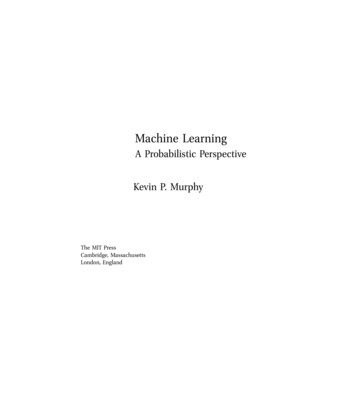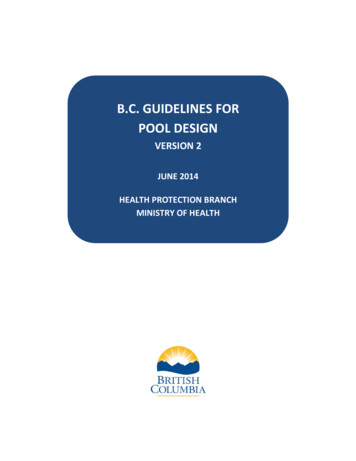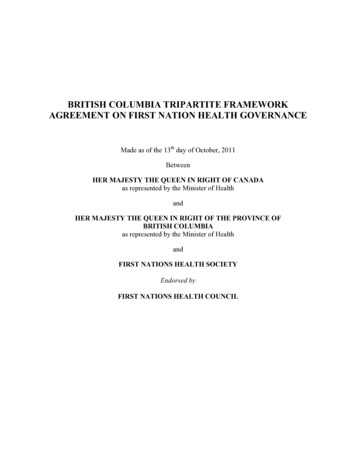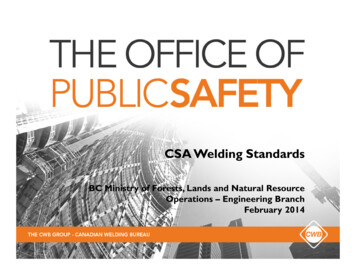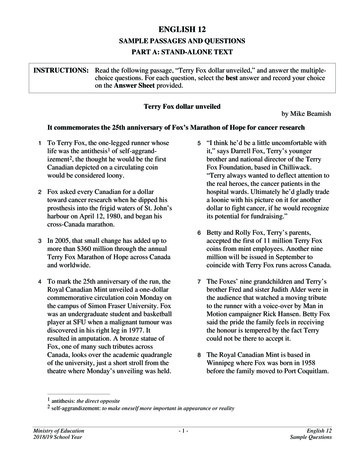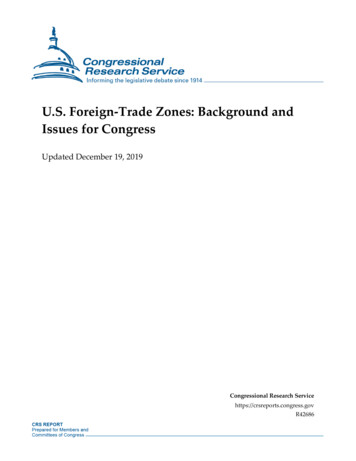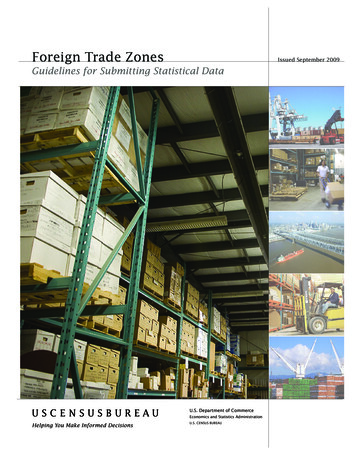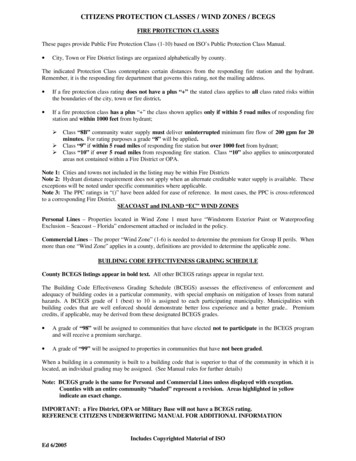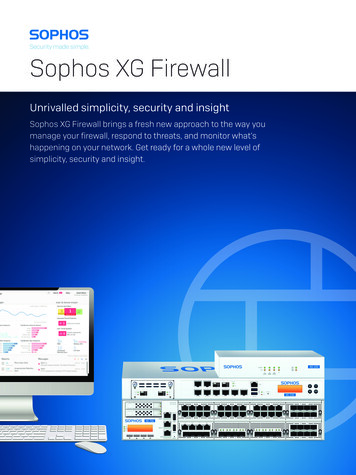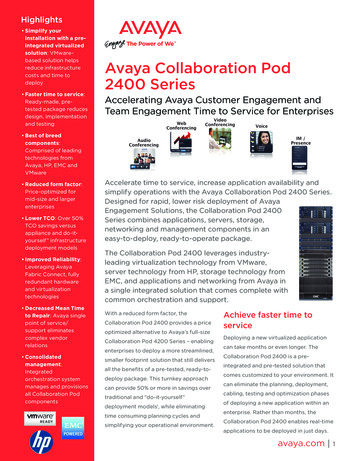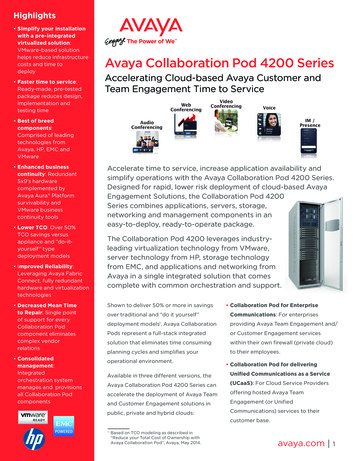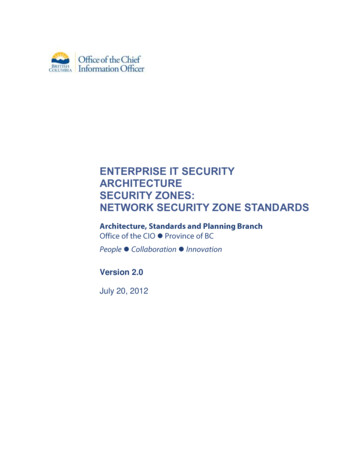
Transcription
ENTERPRISE IT SECURITYARCHITECTURESECURITY ZONES:NETWORK SECURITY ZONE STANDARDS Version 2.0July 20, 2012
Table of Contents1Foreword.12Introduction .12.1Classification .13Scope .14Normative references .25Terms and Definitions .26Requirements .47General characteristics .47.17.1.1Overview of Network Security Zones .57.1.2Summary .67.28Detailed Characteristics and Standard .77.2.1Zone Constructs .77.2.2Standard Elements .87.2.3Inter-zone Connectivity . 107.2.4Intra-zone Connectivity . 117.2.5Enforcement . 12Evaluation criteria. 138.19Enterprise Security Model .4Enquiry Scope . 13References . 14Annex A.Standard for Network Security Zones . 14Mailing, Delivery and Residential Addresses Data StandardsPage ii
DateAuthorVersionChange Reference10/25/2011Christopher Lyons3.0Draft for ASRB review11/08/2011Christopher Lyons3.1Changes proposed by Ronald Warden12/15/2011Christopher Lyons3.1Removal of vendor references as per Malcolm McGregor.12/23/2011Christopher Lyons3.1Changes proposed by ISB1/9/2012Christopher Lyons3.1Changes proposed by David Steffy1/12/2012Christopher Lyons3.1Formatting2/6/2012Christopher Lyons3.2Replaced figure 2 diagram2/15/2012Christopher Lyons3.2Updated IP or port from zone B to Internet4/25/2012Christopher Lyons3.3Removed access from Zone B to Internet and B to SPAN4/27/2012Christopher Lyons3.3Updated Introduction7/17/2012Christopher Lyons4.0Minor updates throughout9/25/2012Christopher Lyons4.1Updated to include cases for zone B to Internet and updateterms.10/02/2012Christopher Lyons4.1Modified Zone C to be only trusted device & trusted userMailing, Delivery and Residential Addresses Data StandardsPage iii
1 ForewordBetween 2005 and 2007 considerable work was conducted to develop an Enterprise IT SecurityArchitecture (EITSA) as part of the Security Enhancement Project (SEP). The architectures described inthe draft documentation were not considered mandatory for core government, and the EITSA was notformally published. The broad architectures described in the EITSA serve as the foundation of thisstandard, and also served as the mandatory security architecture for the SSBC Managed ServicesEnvironment with the STMS datacenter design. The EITSA was not published and therefore is not apublicly available document.The Government of BC has traditionally invested heavily in perimeter security where firewalls andIntrusion Prevention Systems have been intended to provide the bulk of Government’s data protection.Government collaboration with external partners has been carefully funnelled through 3rd Party Gatewayswith extensive security controls. The EITSA was written with the goal of moving Government towards aDefense In Depth posture where many layers of defense from the perimeter right down to the dataencryption all play a role in protecting the enterprise Information Assets.2IntroductionThis standard recommends dividing or segmenting the enterprise network into secure network segmentsor “Security Zones” as an important step in creating a secure layered network infrastructure that isconsistent with moving security controls closer to the data that they are intended to protect.The boundary controls employed to create and secure these zones and other associated network securityservices are included in this standard. The Zone model is consistent with the best practises of Defense inDepth.In addition to the Network Security Zones standard, host-based firewalls, encryption, secure dataprotocols, data loss prevention, and data-level authentication are also considered critical to a long termsuccessful information security strategy.The main body of this document contains informative descriptions that support the implementation of thisstandard.2.1ClassificationThe proposed standard is classified as follows:Table 13StandardTypeNatureReviewScopeNetwork Security ZonesTechnicalTacticalAnnualEnterprise IP networks,including those provided byASD partners.ScopeThis document applies to government. It:Mailing, Delivery and Residential Addresses Data StandardsPage 1
1. Specifies standard for the Network Security Zones; and2. To the entire Government of BC enterprise network, including services delivered by ASDpartners.This document does not apply to:1. Private and public entities which are not directly under the control or governance of theGovernment of BC; and2. Existing legacy mainframe; and3. Services that are provided by third parties and delivered across the Internet (public cloudservices).4Normative referencesInternational Standards ISO 27002:2005OCIO IM/IT Standards /documents/standards/standards manual.pdf Cryptographic Standards for Information Protection (section 6.10) Interim Standards for Information Systems Security and Network Connectivity (section 6.4) Standard for Information STRA Methodology, Process and Assessment tool (section 6.11) Physical Security Technical Standards Web Content Filtering (sections 1.1, 6.2 and 6.3)Information Security Policy rity/policy/isp.pdf Information Security Classification FrameworkInformation Management CPM/12 Info Mgmt and Info Tech.htm 5Ministries must ensure all government technology and information is managed in line withGovernment Core Policy Manual Chapter 12 Information Management and InformationTechnology Management,.Terms and DefinitionsFor the purposes of this document, following acronyms apply.Mailing, Delivery and Residential Addresses Data StandardsPage 2
Table 2AcronymCommentsACLAccess Control ListDLPData Loss PreventionDMZDemilitarized ZoneEITSAEnterprise Information Technology SecurityArchitectureFQDNFully Qualified Domain NameIPSIntrusion Prevention SystemISCFInformation Security Classification FrameworkMPLSMulti-protocol Label SwitchingNATNetwork Address TranslationSAGSecure Access GatewaySPIStateful Packet InspectionSTRASecurity Threat Risk AssessmentVLANVirtual Local Area NetworkVPNVirtual Private NetworkVRFVirtual Routing and ForwardingFirewall RulesA system of security rules that controlby blocking or allowing communicationbetween trusted and untrusted networksegments or hosts.Information AssetAny data created, processed and used bythe Government of BC.Network Security ZoneA physically or logically isolatednetwork consisting of network interfaceswith similar security requirements orprofiles.Mailing, Delivery and Residential Addresses Data StandardsPage 3
6 Requirements1. Information Assets classified in accordance with ISCF will determine the appropriate level ofsecurity measures needed to protect the asset.2. Information Assets are periodically monitored to determine the effectiveness of the measures andcontrols in place with particular focus on those assets deemed High Security.3. The Security Threat Risk Assessment (STRA) must be used by the Information Asset owner toevaluate the risk associated with a given service, or the information associated with a service.This standard is to be used in conjunction with the information security classification and securitythreat risk assessment.4. Staff accessing the information through the network must complete all steps required in CorePolicy and regulations required to have access to Government data.5. All documentation to support the above four points have been completed, authorized and storedaccording to Core Policy and regulations.77.1General characteristicsEnterprise Security ModelThe security controls employed by the BC Government have been divided into four logical groupings:1. Boundary Layers (network segmentation, security zones, network firewalls, network IPS,anomaly detection, proxy/reverse proxy, network encryption, network access control, contentfiltering)2. Trust Levels (device and user validation, user authorization, data level authentication)3. Platform Hardening (host/application firewall, patch management, malware protection, dataencryption, host IPS), and4. Security Management (vulnerability management, asset management, security informationmanagement, review controls).Mailing, Delivery and Residential Addresses Data StandardsPage 4
7.1.1 Overview of Network Security ZonesFigure 1This Network Security Zone standard applies to the Perimeter and Internal Network controls as reflectedin Figure 1 and utilizes network segmentation to create clearly defined Security Zones. The concept ofSecurity Zones is an IT industry, widely accepted best practice for establishing security boundaries,control points and accountabilities. A Security Zone is a logical entity containing one or more types ofservices or entities. Security Zones group together those entities with similar security requirements andlevels of risk. Further segmentation within the Zones is supported to allow each service and businessesprogram the level of security isolation they require.Segmenting networks into well-defined Security Zones involves a number of different security controlsworking in concert. On a local switch, VLANs are used to isolate user groups with Virtual RoutingForwarding (VRF) instances providing policy enforcement. All routing between zones is done withfirewalls and security is enhanced through the additional use of intrusion prevention systems (IPS) andanomaly detection for stronger policy enforcement. Over the wide area network, technologies like multiprotocol label switching (MPLS), and virtual private networks (VPN) are used to isolate traffic andprovide geographic extension of different security zones. Datacenter to datacenter zone extensions mustbe encrypted when required by the data classification except in situations where dedicated privatenetwork facilities are used. Inter-zone security controls are discussed in subsequent sections of thisdocument.This standard defines several Zones and an associated operations management layer or plane. (See Figure2, Security Zones: Connectivity) The architecture supports the classic network Zones such as theDemilitarized Zone (DMZ) and the Internet Zone. It also supports Zones internal to the governmentMailing, Delivery and Residential Addresses Data StandardsPage 5
network such as its shared ISP-like service called SPAN/BC, an Extranet Zone for connectivity withbusiness partners of IT services. In addition, the Zone model provides internal Zones at its core; theRestricted High Security Zone (Zone A), the High Security Zone (Zone B), and the Trusted Client Zone(Zone C). Other Zones that are not reflected in figure 2 include Trusted User (BYOD) Zone, PCI Zone,Guest Zone (Internet only), Building Utility Services Zone, PLNet Zone, Pharmanet Zone, BPS Zone anda Collaboration Zone for edge servers and infrastructure associated with unified communications andcollaboration. Lastly, the zone model supports a highly restricted and segmented operations managementlayer to provide the administrator access required to service the core infrastructure as well as the businessapplications.Figure 2 - Security Zones: ConnectivityThe objective of the internal zones A, B and C are to provide increasing levels of security by limitingtheir visibility and connectivity to other zones and their associated devices.7.1.2 SummaryThe fundamental zone connectivity concepts for the security zones model are:Mailing, Delivery and Residential Addresses Data StandardsPage 6
Not all Zones are visible to all other Zones; only Security Zones adjacent to one another mayinitiate or service communication requests and as a result, there is no Security Zone “hopping”.E.g., desktops in the Trusted Client Zone cannot directly initiate a session with the application datastored in a server in the Restricted High Security Zone as they are not adjacent. Zone extensions (eg. Zone B in the Calgary datacentre to Zone B in the Kamloops datacentre) mustbe encrypted when required by the data classification framework except in situations wherededicated private network facilities are used. The session initiation between the security zones may or may not be bi-directional with an adjacentsecurity zone. E.g., a desktop in the Trusted Client Zone can initiate a session with the Internet, butdevices on the Internet cannot initiate a session with the Trusted Client Zone desktop. The datacenter Management Plane is physically separate from other Zones, and it is internallysegmented. Each server’s dedicated network interface is on its own segmented network andinterfaces on the Management Plane networks do not have visibility to each other. All traffic that transits a Security Zone boundary must pass firewall rules, IPS and anomalydetection. All Internet bound traffic sourced from Zone C, Trusted User Zone, Guest Zone or the PLNet Zonemust pass through content filtering in accordance with the BC Government standard on WebContent Filtering.7.2Detailed Characteristics and Standard7.2.1 Zone Constructs7.2.1.1Management PlaneThere are multiple Management Planes used by the Government of BC and its ASD partners. Thisdocument is specifically concerned with the Management Plane in the datacenter.In the datacenters the Management Plane: Is a construct that is used for performing backups and patch management. Is used for all server administration within datacenters. There is no direct access to the Management Plane. All access to the Management Plane is achieved through a dedicated Secure Access Gateway(SAG) service. IP addresses used in the Management Plane do not have Internet routing.7.2.1.2SPAN/BCThe Shared Public Access Network is an ISP-like service where public entities connect to governmentresources. SPAN is a network that hosts both trusted and un-trusted end-points.7.2.1.3DMZThe DMZ is populated with proxies, web gateways, and other citizen facing interfaces.Mailing, Delivery and Residential Addresses Data StandardsPage 7
Servers and application residing within the DMZ may be Internet accessible and require tighter host andapplication controls than Zone A and Zone B servers.Internet facing applications must undergo an Application Vulnerability Scan prior to be placed in theDMZ.Servers cannot be in IDIR domain if they are in the DMZ. Servers in the DMZ are in the .DMZ domain.A trust relationship exists between IDIR and the DMZ domains.7.2.1.4ExtraNetThe ExtraNet zone serves as a landing point for business partners who require connectivity to internalgovernment services.All ingress and egress traffic from the ExtraNet Zone must pass through a third party gateway equivalentinfrastructure.7.2.1.5Trusted Client Zone (zone C)Zone C is the Trusted Client Zone. All Zone C end-points are managed by Government and usedby trusted users (IDIR).7.2.1.6 Trusted User (BYOD) ZoneThe Trusted User (BYOD) Zone is for end-user devices that are authenticated to the network with IDIRcredentials.7.2.1.7High Security Zone (zone B)Zone B is populated with applications, or databases with data that has a security classification of Low orMedium. High security data may reside in the High Security Zone upon completion of a Security ThreatRisk Assessment and following risk acceptance by the information owner.7.2.1.8Restricted High Security Zone (zone A)Zone A is populated with information, applications or databases with data that are classified as Highsecurity according to the Information Security Classification Framework (ISCF).7.2.2 Standard Elements7.2.2.1Secure Access Gateway (SAG)The Secure Access Gateway is a hardened Virtual Desktop or Terminal Services based service that isused to administer applications or data in the datacenter. The Secure Access Gateway should be used toadminister applications or databases that reside on servers in the Restricted High Security zone and maybe used to administer databases or applications in any datacenter zone.The SAG service design requirements include:Connections to the SAG must be made from Zone C or via a VPN that terminates in Zone C.The SAG service is the best practice for administering applications and databases in Zone A.The SAG service may be used to administer applications or databases in any zone that is adjacent to ZoneB as show above in Figure 2.Mailing, Delivery and Residential Addresses Data StandardsPage 8
SAG users must authenticate against IDIR.Authentication must not pass through from the end-user localhost session to the SAG session.The SAG service must have the capability to support multi-factor authentication.The SAG service must log all connections and session details including failed connection attempts withaccurate time stamps.The desktop delivered by the SAG service must reside in Zone B and will be subject to all Zone B rulesas defined in this standard.The SAG must provide a mechanism to restrict user inter-zone and intra-zone access based on static IPaddress or VLAN assignment.The desktop delivered by the BC SAG must follow a regular patching schedule, maintain up to date antivirus protection, host-based firewall, and support session timeout.Controls must be in place between the end-user localhost and the SAG desktop to restrict the ability tocut-and-paste or transfer files between th
7.1.1 Overview of Network Security Zones Figure 1 This Network Security Zone standard applies to the Perimeter and Internal Network controls as reflected in Figure 1 and utilizes network segmentation to create clearly defined Security Zones. The concept of Security Zones is an IT industry, wi
